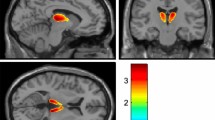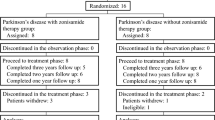Abstract
The dopa analogue 6-fluorodopa (6-FD) used with positron emission tomography (PET) allows in vivo visualization of dopamine and its metabolites in nigrostriatal nerve endings1. We have now found abnormal 6-FD scans in four subjects exposed to 1-methyl-4-phenyl-1,2,3,6-tetrahydropyridine (MPTP). None had parkinsonism. The results suggest subclinical damage to the nigrostriatal pathway. This is the first direct evidence that dopaminergic impairment can exist without clinical deficits. Here we discuss this finding in the context of the hypothesis that Parkinson's disease may stem from clinically silent damage to the substantia nigra, followed by slow attrition of neurones in this region because of its particular vulnerability to cell loss as a normal consequence of ageing.
This is a preview of subscription content, access via your institution
Access options
Subscribe to this journal
Receive 51 print issues and online access
$199.00 per year
only $3.90 per issue
Buy this article
- Purchase on Springer Link
- Instant access to full article PDF
Prices may be subject to local taxes which are calculated during checkout
Similar content being viewed by others
References
Garnett, E. S., Firnau, G. & Nahmias, C. Nature 305, 137–138 (1983).
Langston, J. W. & Ballard, P. Can. J. neurol. Sci. 11, 160–166 (1985).
Langston, J. W. Life Sci. 36, 201–206 (1985).
Teravainen, H. T. & Calne, D. B. in Parkinson's Disease—Current Progress, Problems and Management (eds Rinne, U.K., Klinger, M. & Stamm, G.) 145–165 (Eisevier/North-Holland, Amsterdam, 1980).
Adam, M. J., Abeysekera, B., Ruth, T. J., Grierson, J. R. & Pate, B. D. J. nucl. Med. 26(5), P125 (1985).
Ter-Pogossian, M. M., Ficke, D. C., Hood, J. T., Yamamoto, M. & Mullani, N. A. J. Computer Assisted Tomography 6, 125–133 (1982).
Evans, B. et al. IEEE Trans. nucl. Sci. NS-30, 707–710 (1983).
Horne, M. K., Chang, C. H. & Wooten, G. F. Pharmacology 28, 12–26 (1984).
Calne, D. B. & Langston, J. W. Lancet ii, 1457–1459 (1983).
Garnett, E. S., Firnau, G., Nahmias, C., Sood, S. & Belbeck, L. Am. J. Physiol. 238, R318–R327 (1980).
Martin, W. R. W., Boyes, B. E., Leenders, K. L. & Patlak, C. S. J. cerebral Blood Flow Metab. (in the press).
Lieberman, A. N. & Goldstein, M. New Engl. J. Med. 312, 509 (1985).
Nutt, J. G., Rosin, A. J., Eisler, T., Calne, D. B. & Chase, T. N. Archs Neurol. 35, 827–830 (1978).
Kushinsky, K. & Hornykiewicz, O. Eur. J. Pharmac. Vol? 41–50 (1974).
Langston, J. W. in Recent Advances in Parkinson's Disease (eds Fahn, S., Marsden, C. D., Jenner, P. & Teychenne, P.) (Raven, New York, in the press).
Garnett, E. S., Nahmias, C. & Firnau, G. Can. J. neurol. Sci. 11, 174–179 (1984).
Author information
Authors and Affiliations
Rights and permissions
About this article
Cite this article
Calne, D., Langston, J., Martin, W. et al. Positron emission tomography after MPTP: observations relating to the cause of Parkinson's disease. Nature 317, 246–248 (1985). https://doi.org/10.1038/317246a0
Received:
Accepted:
Issue Date:
DOI: https://doi.org/10.1038/317246a0
This article is cited by
-
Lewy bodies, iron, inflammation and neuromelanin: pathological aspects underlying Parkinson’s disease
Journal of Neural Transmission (2023)
-
Early Postnatal Exposure to Paraquat and Maneb in Mice Increases Nigrostriatal Dopaminergic Susceptibility to a Re-challenge with the Same Pesticides at Adulthood: Implications for Parkinson’s Disease
Neurotoxicity Research (2020)
-
Common Variation in the DOPA Decarboxylase (DDC) Gene and Human Striatal DDC Activity In Vivo
Neuropsychopharmacology (2016)
-
Früherkennung der Parkinson-Krankheit
Der Nervenarzt (2013)
-
Neuroimaging in the early diagnosis of neurodegenerative disease
Translational Neurodegeneration (2012)
Comments
By submitting a comment you agree to abide by our Terms and Community Guidelines. If you find something abusive or that does not comply with our terms or guidelines please flag it as inappropriate.



